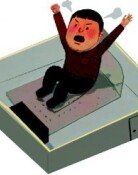Sacrifice for the greater cause
Sacrifice for the greater cause
Posted February. 25, 2021 07:34,
Updated February. 25, 2021 07:34

All art is political since art works are meant to reflect the situation and the agony of the times the artist lived. Jacques-Louis David would be the artist who painted the most political paintings in the history of art. When French Revolution shook France in 1789, David painted the story of Brutus, who sacrificed his own son for his political convictions, and exhibited it at the Paris Salon, causing a great sensation.
Lucius Junius Brutus led the revolt that overthrew the despotic king in 509 BC and founded the Roman Republic. The ousted king, Lucius Tarquinius Superbus plotted a revolt with the sons of patricians, including two of David’s sons. When it was found that his sons were involved in the plotting, David immediately ordered to execute his sons. David painted the scene, where the bodies of David’s two sons were brought to Brutus, on a big canvas. Brutus, the hero of the Republic, is sitting alone on the left side of the painting, contemplating. He does not even turn his eyes to the bodies of his sons. On the other hand, his wife on the right is holding her two horrified daughters and crying, reaching out her arms to the bodies of her sons. One of the daughters is about to faint. The woman covering her entire face with a blue cloth is a servant. As a court painter for his entire life, who had only painted the expressions and hearts of men in power, was it too difficult for David to portray the sad emotions of a servant? He decided not to draw the expressions on her face by covering it with a cloth.
In fact, David was quite a political painter. He enjoyed a reputation as a court painter to Louis XVI but when revolution broke out, he became the official painter of the revolutionary government, which executed his king by guillotine. David stood at the forefront of art in the revolutionary era by releasing a series of paintings that represented revolutionary spirit. When Napoleon Bonaparte came to power, David aligned himself with him again, serving as a painter for the Emperor.
Despite his dizzying changes of loyalty during the political turmoil, David was able to continue his career by drawing paintings that both revolutionary and counter-revolutionary sides wanted. No painter has better promoted the virtue of personal sacrifice for the greater cause than David.







